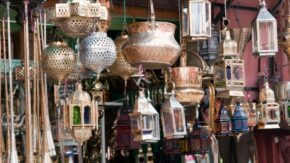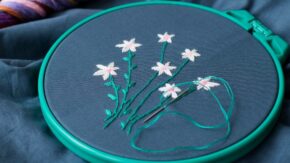Textile craft is the art of skillfully working with fabrics, fibers, and threads to create both functional and decorative items. It’s a blend of creativity and craftsmanship that transforms raw materials into intricate designs and garments.
There are lots of different textile and fiber crafts to get involved in, including bobbin lace, felting, knotting, Chinese knotting, and Macramé. Other popular trends include rug-making, spinning, weaving, tatting, flower crafts, and stitching.
Textiles are defined as unfinished items or those that can be combined with other materials to make something. In contrast, fiber includes basic crafts on crochet, knitting, sewing, and weaving and is subdivided into different types.
You’ll need a wide range of different tools for textile and fiber crafts, including a sewing machine, needles, measuring tools, thimbles, and embroidery hoops, depending on what textile craft you decide to pursue.
A variety of different materials are needed by crafters working with textile and fiber crafts. Of course, exactly what you’ll need depends on your chosen craft, but some materials include fabric, yarns, ribbons, buttons, beads, and different patterns to work from.
There are plenty of benefits to be had from taking up textile crafting as a hobby. Working with your hands to create beautiful items you can wear or use around your home is a great way of fighting stress and anxiety, as well as developing patience and control, and stimulating your creative side. As well as preventing mental deterioration, crafting improves self-esteem, and joining a textile crafting community helps to strengthen social ties and make new friends.
To learn textile crafting, you must research and explore the whole gamut of potential craft fields until you find one that fits your wants. It’s a good idea to join a crafting community of like-minded individuals to learn from and socialize with, and check out plenty of online courses and websites for more information.
Once you’ve decided on a textile craft to pursue, gather the supplies and equipment you’ll need, set aside a workspace, and start with the basics.
Keep reading to find out everything you need to know about textile crafting in its many, varied forms!
What Is Fiber And Textile Craft?
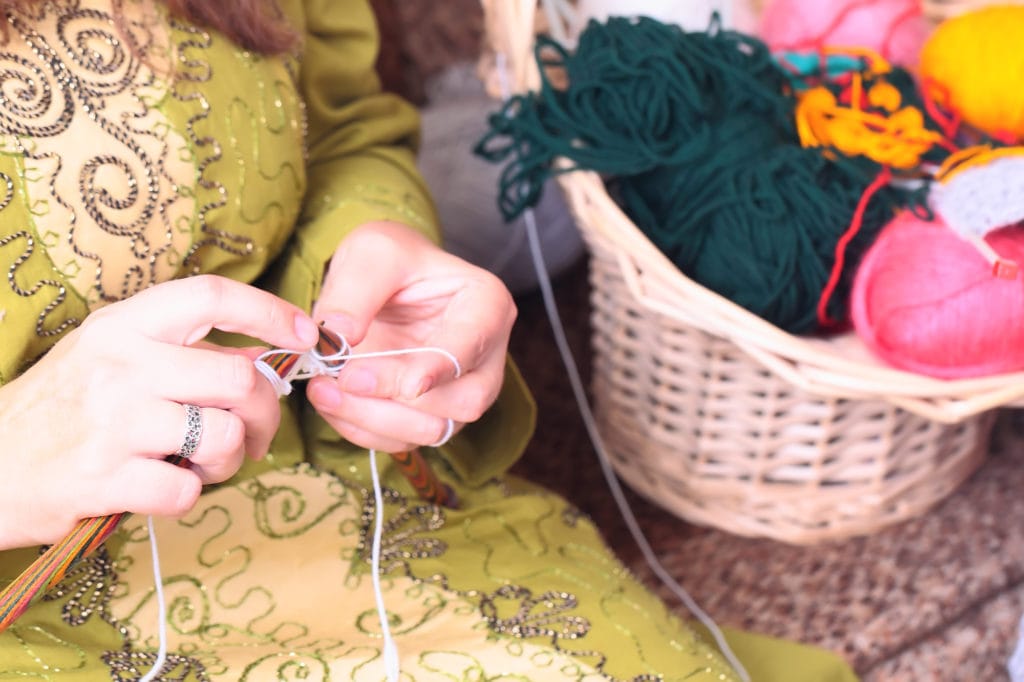
Textile and fiber craft involves using man-made, animal, or plant fibers to make and decorate practical objects and clothing. These crafts include embroidery, sewing, weaving, quilting, and many other techniques.
Textile craft entails using a piece of fabric to make something from, whereas fiber craft uses strands of thread to knot, knit, or weave an item.
What Is The Difference Between Textile And Fiber?
The difference between textile craft and fiber craft is explained fully below, offering insights into their unique characteristics and how they contribute to the world of creative craftsmanship.
Textile
Textiles are pieces of material or fabric that are used to create items of clothing, decorative articles, and functional craft pieces like quilts, suits, and kitchen aprons.
Fiber
Fiber is a single strand that’s spun together with other strands to create yarn. The yarn is then woven, knotted, or knitted together to create textiles, fabric, or decorative items.
What Are The Different Types Of Textile Crafts?
There are many different types of textile and fiber crafts to choose from.
When deciding what crafting hobby would suit you best, consider the space you have available in your home for use as a workspace and storage. If you want a craft that shows results quickly, avoid knitting and crocheting, which generally take much longer to produce a finished article than stitching and flower crafts.
Here’s an overview of the textile crafts and fiber crafts you might fancy trying your hand at!
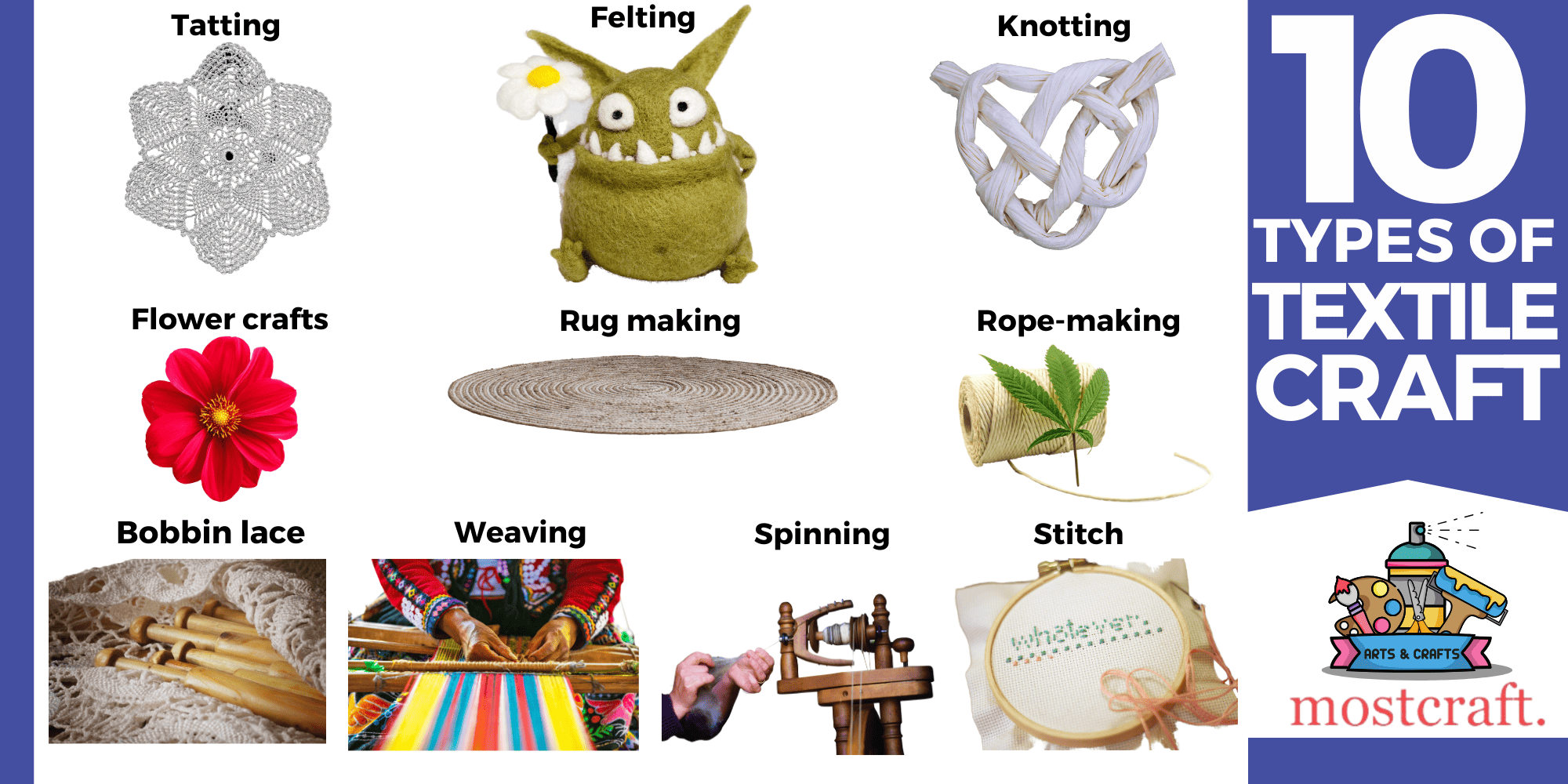
Bobbin Lace
Bobbin lace is a beautiful lace textile that’s created by twisting and braiding lengths of thread, which you wind onto bobbins to manage them. As you work, your weaving is held in place by a number of pins set in a pre-defined pattern into a lace pillow.
You can use bobbin lace for trimming and decorating furnishings, collars, and dresses. Popular materials used for bobbin lace include brightly colored silk and gilt gold and silver threads.
Felting
Felt is a high-quality fabric that’s made by pressing and needling natural or synthetic fibers, usually wool or acrylic, together to create a textile. While wool produces a fuzzy fabric, adding synthetic fibers increases the fabric’s durability.
Your finished felt fabric can be used to make kid’s toys, hats, clothing, and games (remember Fuzzy Felt kits from your childhood!)
Knotting
If you have lots of patience and nimble fingers, the craft of knotting might be for you. There are two types of knotting, which are explained in more detail below.
Chinese Knotting
Chinese knotting involves creating a symmetrical shape from one length of thread to make a seamless design that’s identical on both sides. A red cord was used traditionally to create good luck charms that would keep evil spirits at bay and bring the owner luck and prosperity.
Macramé
Macramé is a textile craft that uses decorative knots from macramé cords or strings. You can create elaborate patterns to make bags, plant hangers, wall hangings, and even jewelry.
Rope-Making
Rope is made from natural or synthetic yarns, fibers, strands, or plies that are braided or twisted together to form a larger, stronger form. Rope is very strong, making it perfect for lifting and dragging heavy objects, and was traditionally made using whatever fiber was locally available.
Professional ropemakers produce ropes for floating vessels and for use in a maritime environment, whereas rope made by crafters is usually created to make decorative items.
Rug Making
Rug makers make floor coverings from textiles such as wool in a tradition that dates back to the New Stone Age. Various techniques and tools are used in this craft, including rag rugs, flat weaving, and hand-knotting.
- In hand knotting, rugs are made by tying knots onto warp threads to create the rug’s pile, which can then be trimmed to make it uniform in appearance.
- Hand-tufting involves pushing tufts of fabric or yarn through the rug’s base fabric with a needle before securing them in place with a backing.
- The hand-weaving method of rug-making involves interlacing the warp and weft threads on a loom to create a rug.
- Hand-hooking entails pulling strips of yarn or fabric through a base material to create the rug’s pile.
- Hand-braiding takes strips of yarn or fabric and braids them together to make the rug’s body, which is then coiled and stitched in place to make it secure.
Spinning
The craft of spinning involves turning fibers of either animal or plant origin into yarn by hand using either a spinning wheel or spindle.
Spinning has been around for over 10,000 years, and although the earliest yarns were made without tools, being twisted rather than spun, for thousands of years, most spinning was done using a spindle.
When a drop spindle is used, gravity pulls the spindle toward the ground as it spins. With a suspended spindle, the spindle spins on a set surface like a top, with the thread being created by pulling the fiber away from the spindle.
Stitch
Stitching is an umbrella term that’s used to describe crafts where textiles are stitched together to create clothing or functional items, and embroidery, where colored thread is used to create a pattern or picture on a piece of fabric.
Tatting
Tatting is a form of lacemaking that crafters typically use to make accessories like doilies, necklaces, earrings, collars, and other decorative pieces. The lace made by tatting is extremely durable and is formed using a series of loops and knots.
Weaving
Weaving is a textile art that’s used to make carpets, rugs, and wall hangings.
To create the woven textile, two sets of yarns or threads, called warp and weft threads, are interlaced together on a loom at right angles to create cloth or fabric. The weft threads run horizontally, while the warp runs vertically. You can weave cloth in one plain color or you can create complex designs if you have a more complex loom with more heddles to keep the warp threads in line and create the interlaced effect.
Flower Crafts
Making fabric flowers from scraps of cloth is a great way to upcycle and repurpose unwanted items of clothing and off-cuts from fabric shops. There are plenty of online tutorials explaining how to get into this simple, rewarding craft, and it’s a good choice for kids who want to get into crafting.
The flowers you make can be used to decorate clothing, embellish soft furnishings, and create kids’ jewelry.
What Are The Different Tools Used For Textile Craft?
The different tools used for textile craft vary tremendously, depending on what craft you want to get into. Some are relatively small and easy to store, whereas others are much larger and demand a dedicated workshop to accommodate them.
Here’s an overview of the different tools you might need for textile craft.
Scissors
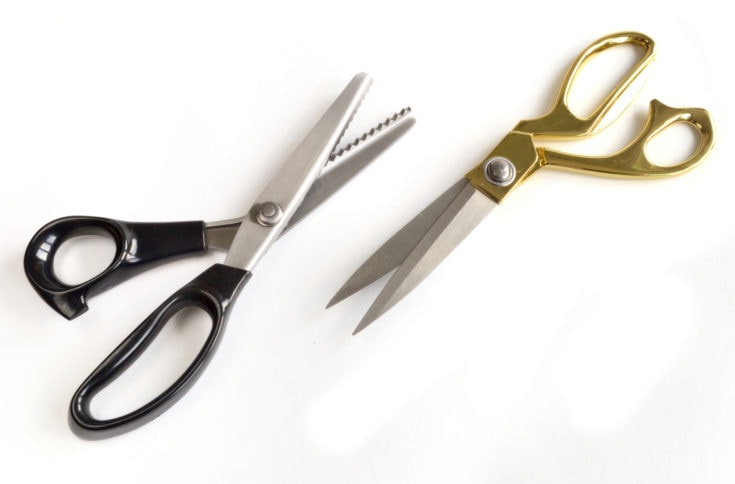
At least one sharp pair of scissors is essential for most textile crafts. Choose scissors of an appropriate size and shape for your chosen craft and go for the best quality you can afford, ideally with ergonomic handles to prevent strain on your hand and fingers.
Sewing Machine
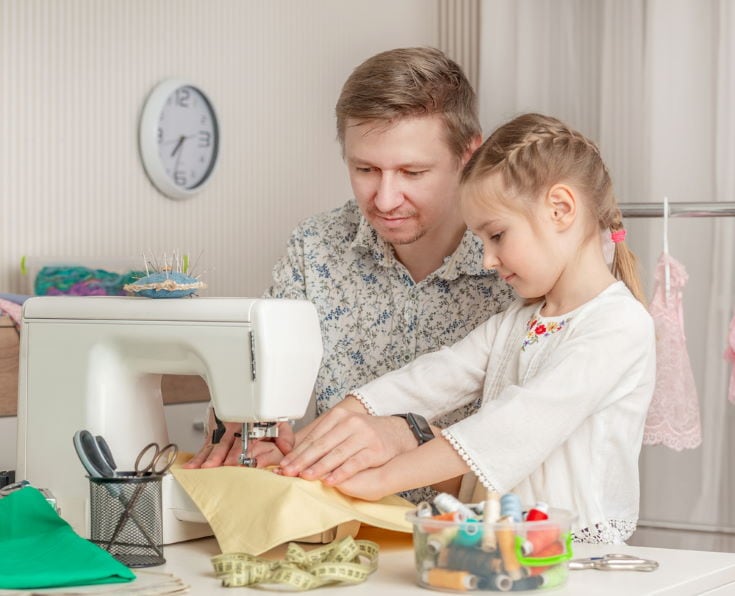
Some textile crafts like sewing and stitching need a sewing machine. My first sewing machine was an ancient thing with no fancy features, but today there’s a vast range of machines to choose from. You can even buy machines that will create embroidered stitching and pre-programmed designs at the touch of a button.
However, suppose you’re starting on a limited budget. In that case, it’s best to pick a basic model of decent quality and upgrade it when you become more proficient and experienced in your chosen textile crafting hobby.
Knitting Needles And Crochet Hooks
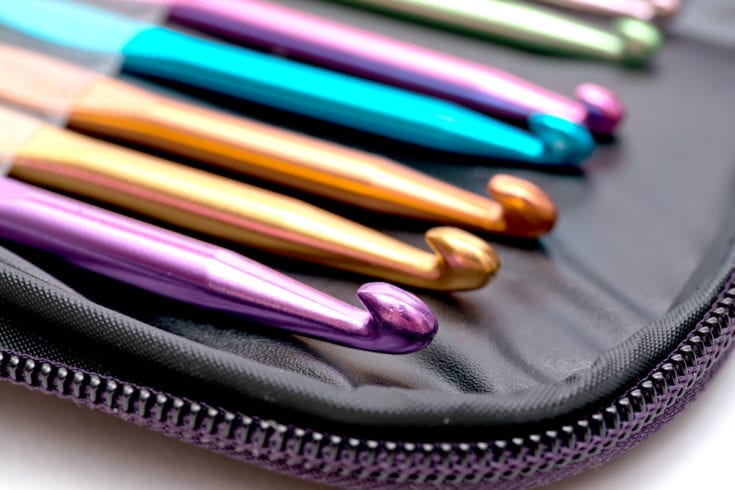
If you want to learn how to knit or crochet, you’ll need a variety of knitting needles and crochet hooks. Depending on the knitting pattern and the size of the yarn you’re working with, you’ll need different-sized needles, so choose a pattern to work from and buy the needles it asks for.
Weaving Tools
Weaving needs quite a few specialist tools and a large area in which to work and store your materials and projects.
- Weaving loom
- Tapestry needles
- Warp yarn
- Shed stick
- Weft yarn
- Weaving shuttles
- Weaving comb
Embroidery Hoops
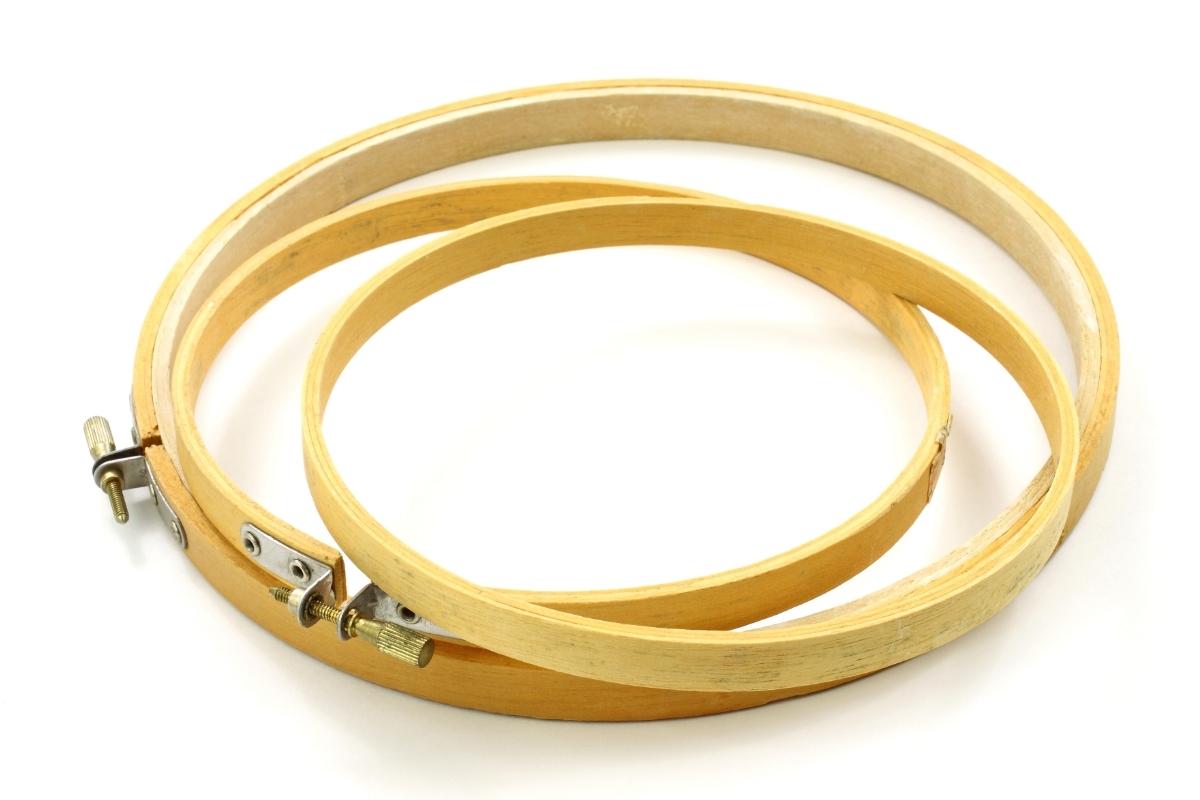
Most forms of embroidery need an embroidery hoop to hold the fabric taut, helping you to make neater stitches and prevent puckering. Embroidery hoops come in different sizes, and as you get into the hobby, you’ll acquire a range of them, depending on the projects you’re working on.
Felting Needles
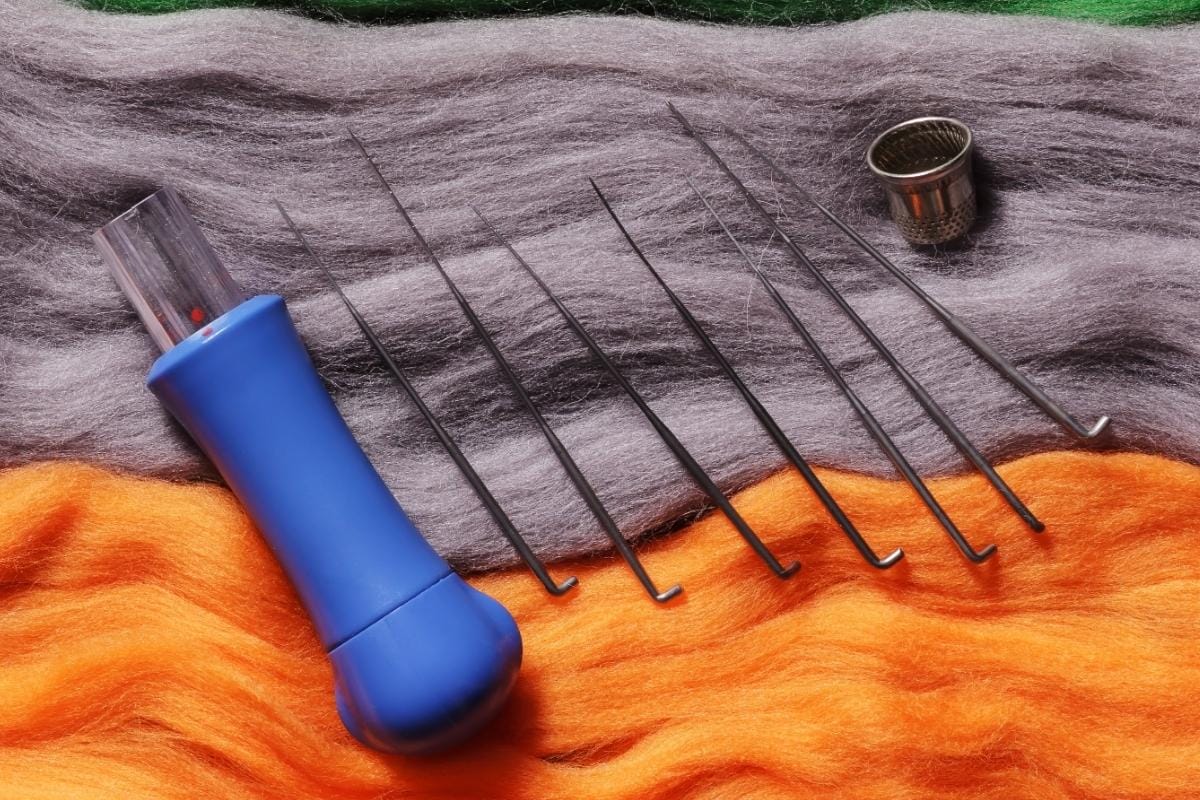
Felting needles are not like regular sewing needles. A felting needle has tiny barbs on the tip and are usually longer and thicker. You use a felting needle to tangle and join wool fibers to create a piece of felt fabric.
Measuring Tools
Many textile crafts use some form of measuring tool to create the precise dimensions required for the finished piece.
Measuring tools range from pliable fabric tape measures to metal extending ones and straight edges, depending on the material you’re working with.
Pins And Needles
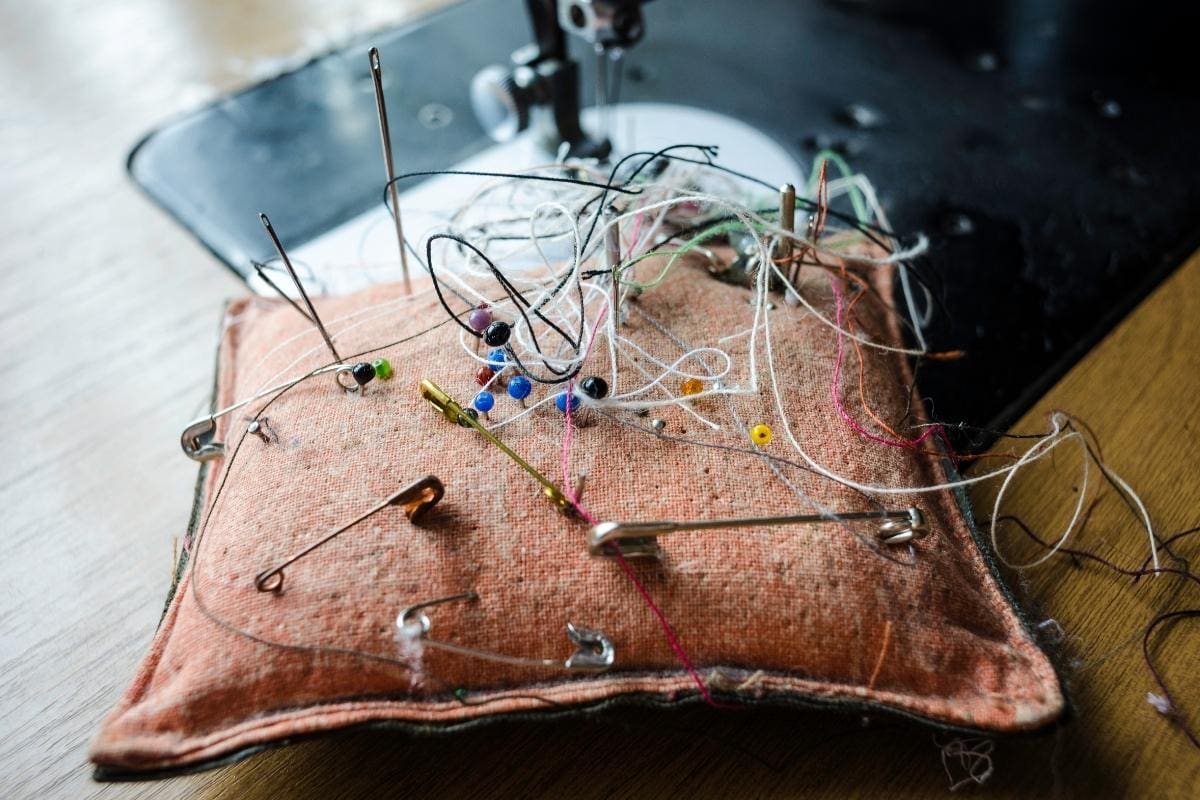
Sewing crafts require pins to hold the pieces of your material together while you tack or stitch the item together, and you’ll need needles of various sizes for hand-stitching and finishing your work and needles for your sewing machine.
Thimbles
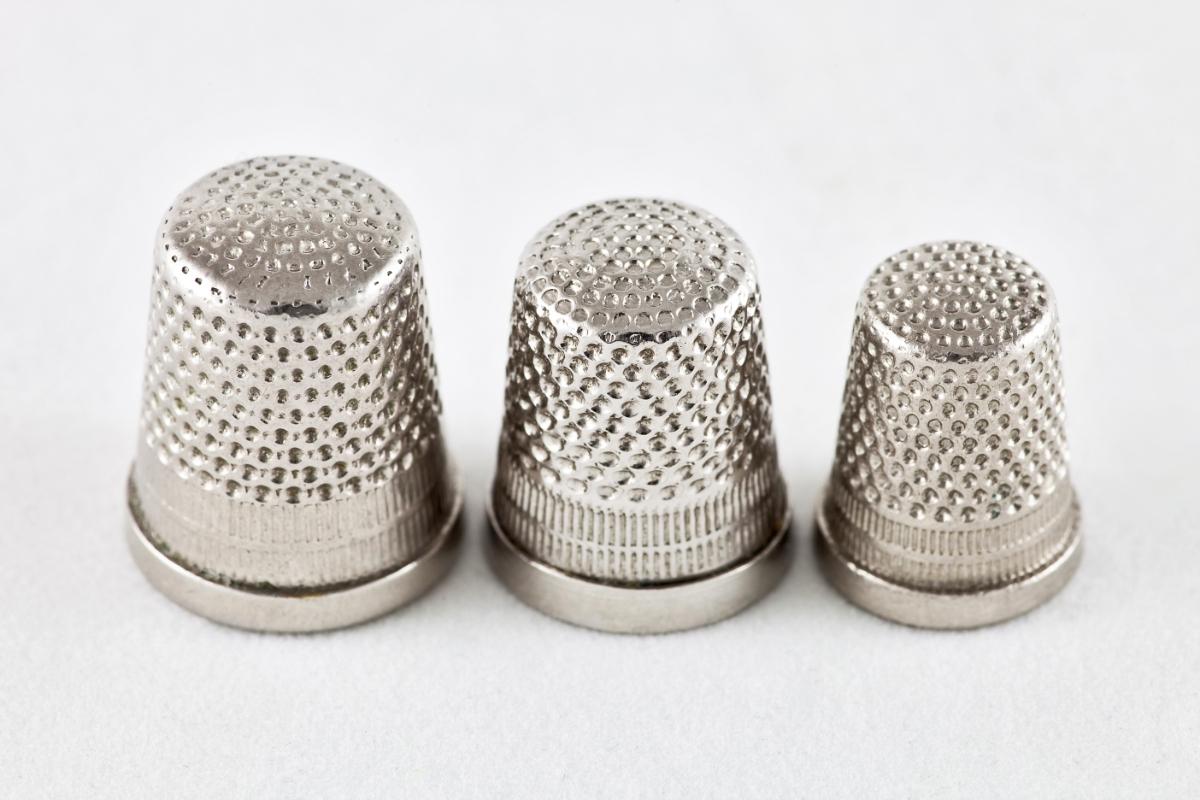
If you’re hand-stitching, you’ll need to use a thimble to protect your thumbs from sharp needles. Speaking from experience, blood spots are extremely difficult to shift, and the last thing you want is to accidentally impale yourself on one of your needles or pins while you’re working!
Iron And Ironing Board

Most households have an iron and an ironing board, and you’ll need both of those if you want to make clothing and soft furnishings for your home. Even simple stitching crafts demand a seam or hem on the fabric, and ironing one before you pin and sew it is the best way to keep the seam flat and keep it crisp.
Bobbin And Spool Holders
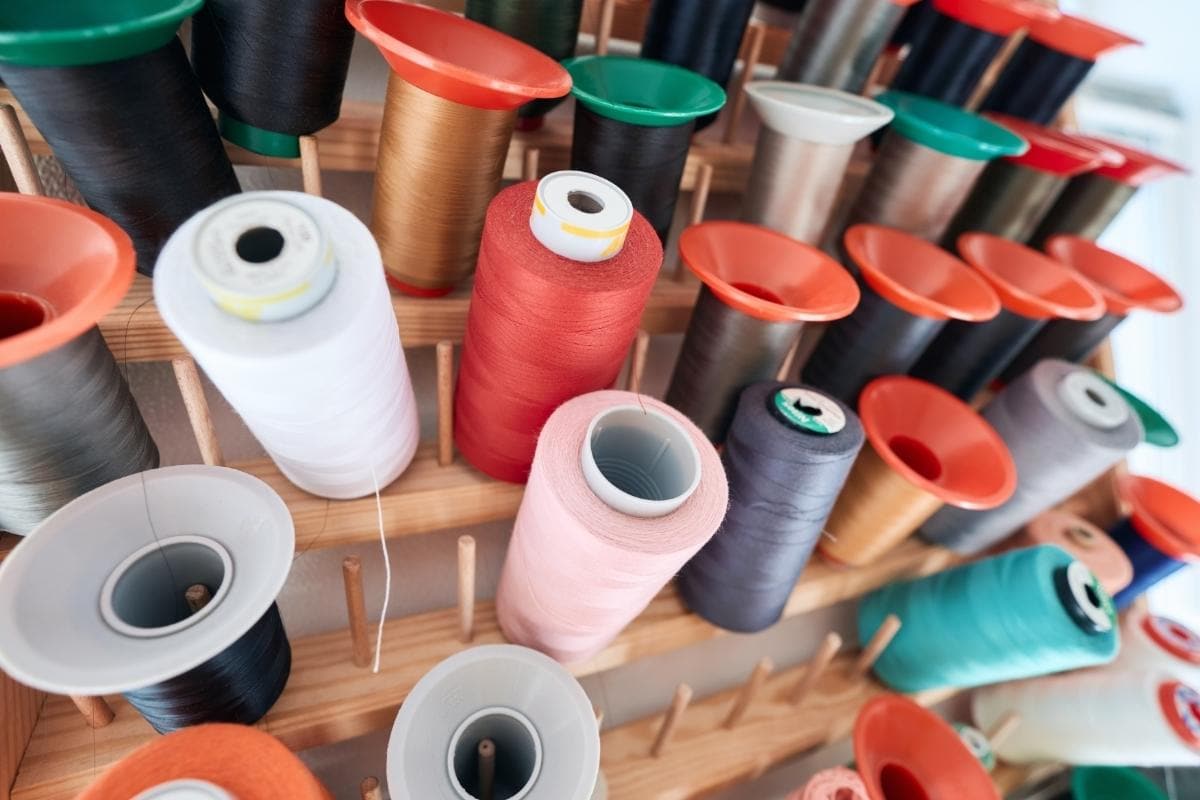
Bobbin and spool holders come in various forms, including clips, and you can get neat racks for keeping your thread tidy and safe.
Yarn Swift And Ball Winder
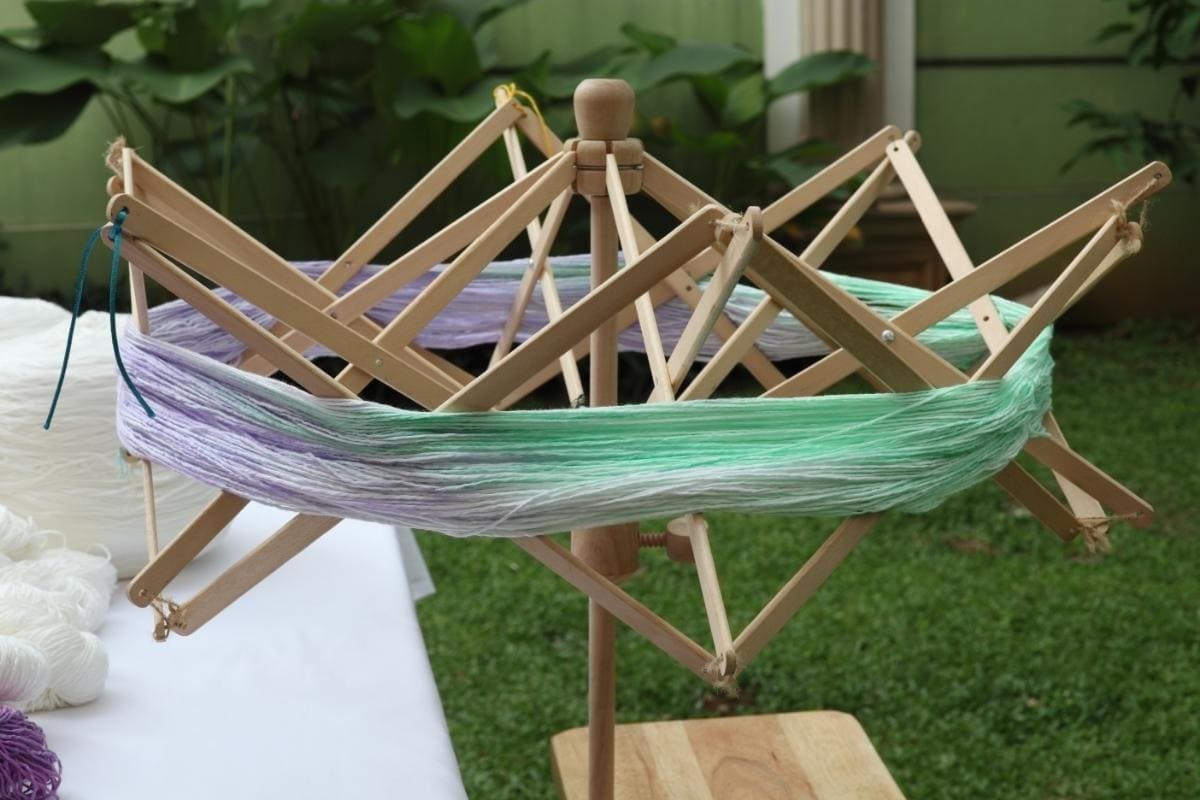
A yarn swift and ball winder makes the process of winding your yarn much easier and quicker, leaving you more time to get into your next project rather than spending time on mundane housekeeping tasks.
The swift holds the yarn and prevents it from tangling as the ball winder winds your thread into a neat little ball.
Punch Needles
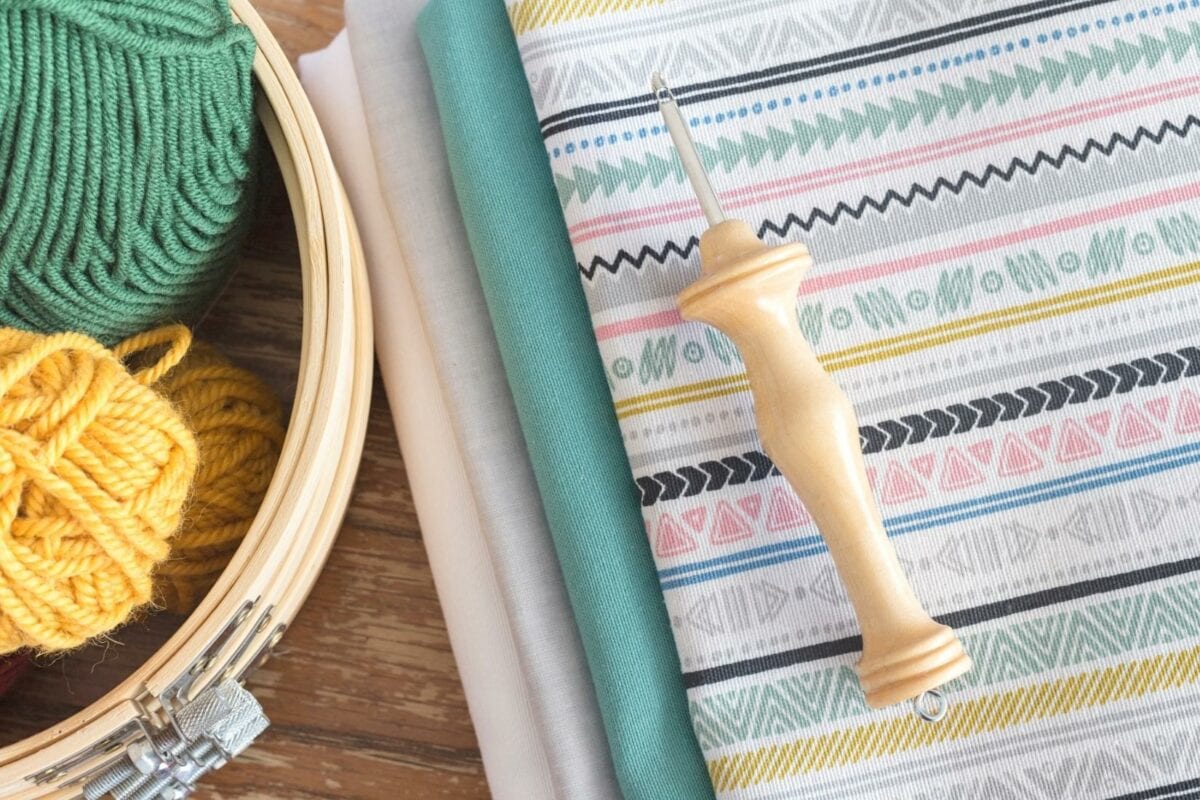
Punch needle art is a very simple form of embroidery textile craft that involves punching loops of yarn into the fabric using an oversized needle-like tool. Unlike other forms of needlework, punch needle art is a fast process that makes it super-easy to create decorative items for your home, like wall hangings and cushion covers. You can also use this technique to upcycle old clothing items or brighten up old bags.
Older kids can get into this form of crafting, and it’s ideal for you if you want a therapeutic hobby you can do while relaxing in front of your favorite TV shows!
What Are The Different Materials Used For Textile Craft?
The materials are different for each textile craft, although you can sometimes combine them to create different effects or embellishments. All these materials come in a vast array of different colors and textures, making it easy to create unique pieces you’ll never see twice!
Here’s an overview of the different materials used for textile craft.
Yarn
Yarn is defined as a continuous length of interlocked fiber used in textile crafts like crocheting, knitting, embroidery, weaving, making fabric, and ropemaking.
Yarn comes in many different colors and thicknesses and is an integral part of pretty much all textile crafts.
Fabric
Fabric is sometimes called material or cloth and is made by weaving together threads, typically wool, cotton, silk, nylon, and the like. You use fabric to make clothes, bedding, drapes, and other home soft furnishings, etc.
Thread
Thread is another word for yarn that you use to fix two or more fabric pieces together in textile crafting. Thread can be comprised of the same fiber content as the material you’re working on but is often different. For example, embroidery thread is usually silk or satin in contrast to a plain cotton or synthetic base material that the design is stitched onto.
Fiber
As previously mentioned, textile fiber is a natural or synthetic structure that you can spin into yarn and then use to weave, knit, or bond into a piece of fabric.
Notions
In textile crafts and haberdashery, notions are small accessories or objects that can be sewn or otherwise attached to a finished garment or other article. For example, snaps, buttons, and collar stays are all types of notions.
The term notions is also used to describe these small tools used in stitching crafts, such as thread, needles, pins, seam rippers, elastic, and marking pens.
Loom
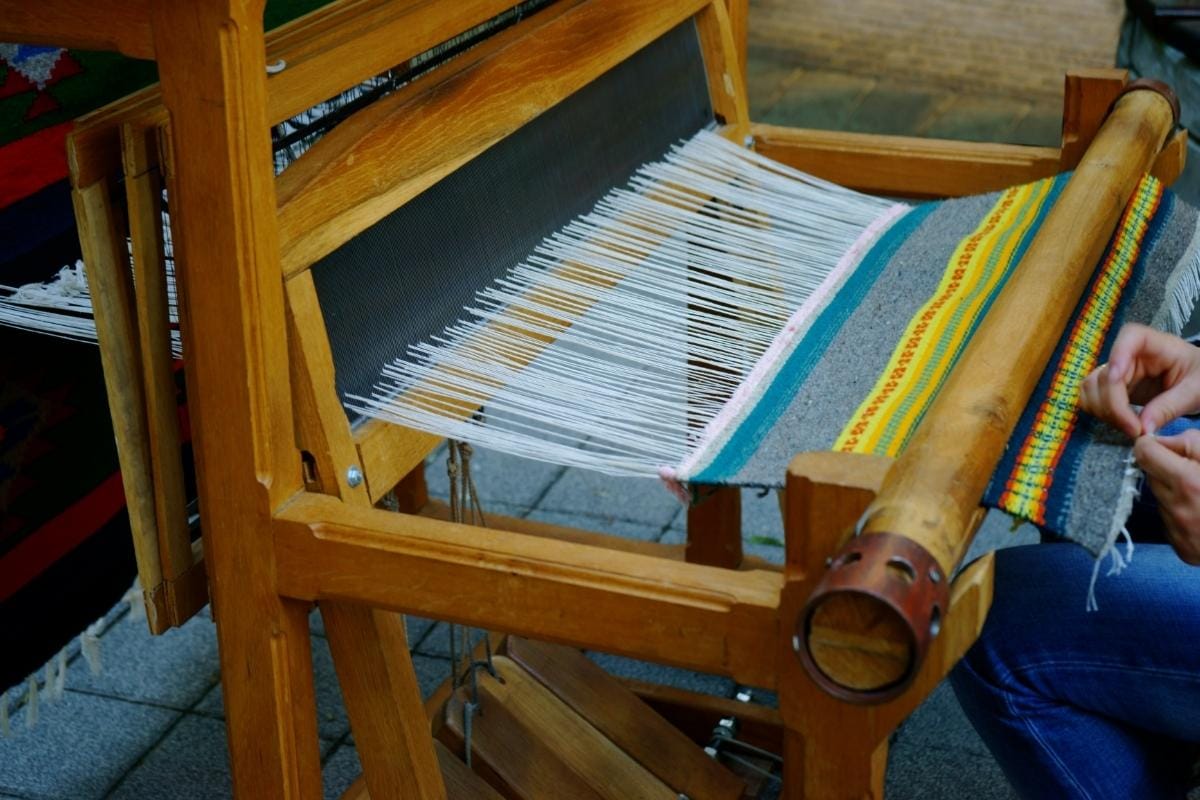
A loom is a piece of machinery that you use to weave cloth, carpet, and tapestry. The basic idea of a loom is to hold the warp threads under tension so that you can interweave the weft threads.
Warp threads are the long yarn that runs vertically up and down a roll of fabric, determining the vertical pattern repeat regardless of how wide the fabric is. Weft is the yarn that runs horizontally across the material, generally being shorter and determining the horizontal pattern repeat, no matter how wide the fabric is.
Ribbon
Ribbons are an extremely popular form of embellishment and decoration used in textile crafting. A ribbon is a thin band of fabric, usually cloth but sometimes metal or plastic, that can also be used for decorative binding and tying.
Cloth ribbon is made from natural or synthetic fabrics, such as Cotton, silk, jute, nylon, polypropylene, and polyester.
Buttons And Beads
Buttons and beads are used in textile crafts to decorate finished items and come in a wide variety of shapes, colors, and sizes and can be made of natural or synthetic materials like wood, plastic, enamel, or metal. Buttons are also used as fastenings in garment making.
Patterns
Patterns are used in many textile crafts, including embroidery, knitting, and dressmaking. A pattern is a detailed set of instructions that shows you how to make a garment or transfer a design onto cloth.
Depending on what you’re working on, you might need to cut out the pattern and pin it onto your chosen material before cutting out the material and stitching the pieces together. If you’re knitting, the pattern tells you what size needles and gauge of fabric you’ll need and explains what stitches to use.
What Are The Benefits Of Learning Textile Craft?
The benefits of learning textile craft can really improve your quality of life! Sitting down to work on a project can help reduce stress, improve your focus, and boost your mood, and that is just for starters!
Get Creative
Everyone has a creative side, and working on a piece of textile craft can help to stimulate yours. Even if you’re working to a specific pattern, there’s still scope to make the piece unique by choosing the thread, yarn, and material you use. You can then let your creativity run wild by embellishing the piece you’ve created with ribbons, buttons, beads, or lace of your choice.
Help Develop Control And Patience
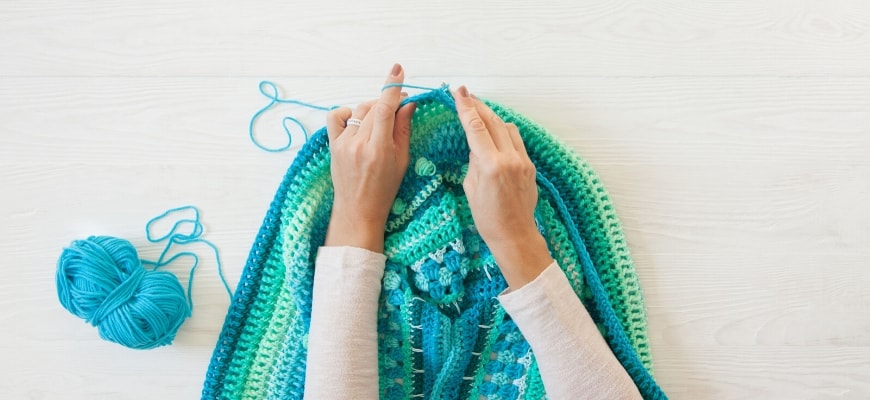
If you tend to be impatient and want things done “yesterday,” textile crafts can teach you to be more patient and control your impulsive urges. Many of these crafts demand intricate detail and quite a lot of preparation before you can start working on a project, so there’s no point in rushing.
Keeps Cognitive Dysfunction At Bat
If you get into a craft like stitching, crocheting, knitting, or weaving, you’ll need to plan each project meticulously and spend time researching what you’ll need to do to bring it to completion. That helps to keep your mind active and can prevent mental deterioration, which makes crafting an excellent hobby for seniors, especially those with early-onset dementia.
Helps Reduce Stress
Juggling work and home life can be stressful in today’s busy world, and settling down to work on a piece of craft can help to relax you and reduce anxiety. Once you finish your project, the end result gives you a tremendous sense of accomplishment, and that can really boost your mood.
Improves Your Self-Esteem
In a similar vein, completing a beautiful, useful item can give your self-esteem a boost, too, which is brilliant for those who are struggling with depression or are just feeling down.
Helps Make New Friends
When you start learning a new craft, it’s a great idea to join a workshop either in real-time or online. That not only gives you access to a mine of information but also gives you a chance to get to know other like-minded crafters and make new friends.
Where To Start Learning Textile Craft?
Learning textile crafts is a great way to relieve stress, learn new skills, and make new friends. So, how do you get started in this wonderful hobby?
Research And Explore
The first thing you must do is decide what textile craft you want to learn. Bear in mind what space you have available in your home and how much time you’re prepared to spend working on your chosen hobby.
Do plenty of research to find out what interests you the most before you buy any materials or tools.
Set Clear Goals
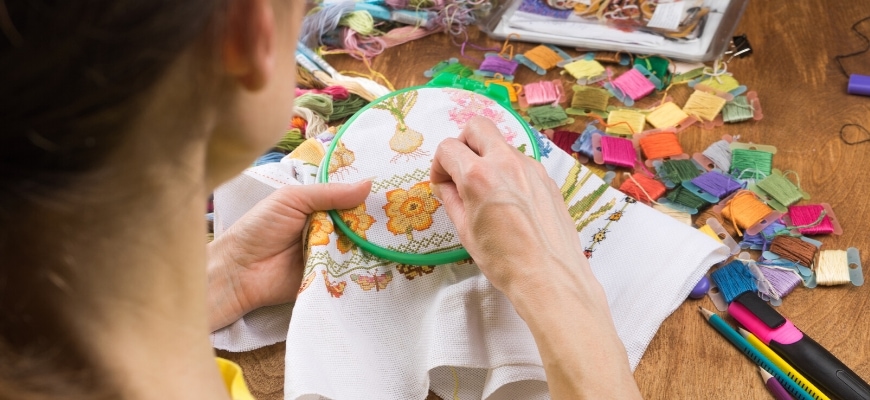
Once you’ve decided what type of textile craft you’d like to take up, set yourself some clear goals. It might be that you are happy to tackle one or two simple projects every few months as a way of relaxing after work in the evenings, or you might have loftier ambitions like starting your own crafting business selling the pieces you’ve made.
Gather Basic Supplies
Now, you can start gathering the basic supplies you will need for your chosen craft. I recommend starting small with just a few simple tools and a modest supply of thread, yarn, and fabric. That way, if you find that a particular craft is not for you after all, you haven’t spent a fortune, and a change of direction will be much simpler and less expensive.
Learn The Basics
You can’t run before you can walk! Take the time to learn the basics of your new hobby.
Once you’re proficient and confident in what you’re doing, you can expand your repertoire of skills and take on more challenging techniques, but the basics will always underpin everything you do, so don’t skimp on learning them.
Practice Regularly
Practice definitely makes perfect in any hobby or new skill. So, be ready to spend a lot of time practicing and experimenting if you want to improve.
Join A Community
It’s a great idea to join a community of like-minded crafters who are interested in the same textile crafts as you. That way, you can learn from others, make new friends, and discover new opportunities for promoting and selling your work if that’s what you ultimately want to do.
Take Classes Or Workshops
There are plenty of classes or workshops in textile crafting, and we strongly recommend taking advantage of at least one or two of them. Whether you want to take up crafting as a casual hobby or hope to start a cottage industry selling your work, you can never learn enough, and formally organized classes are the perfect way to do that.
Experiment And Innovate
Once you have learned the basics of your chosen craft and you’re proficient in them, you can experiment with different techniques, and you might even innovate and develop the unique style that sets you apart from the crowd!
Making something different from the norm can give you a tremendous sense of achievement. For example, I had a very basic, rather temperamental, old sewing machine, but that didn’t stop me from buying a basic, simple pattern, some lovely fabric, and pearl beads and making my wedding dress! I used the basic pattern to get the overall shape and fit of the dress and then stylized and embellished it so that I ended up with a totally unique dress that was an absolute one-off.
Now, that was not only innovative, but it gave me a sense of achievement that’s never been repeated!
Build A Reference Library
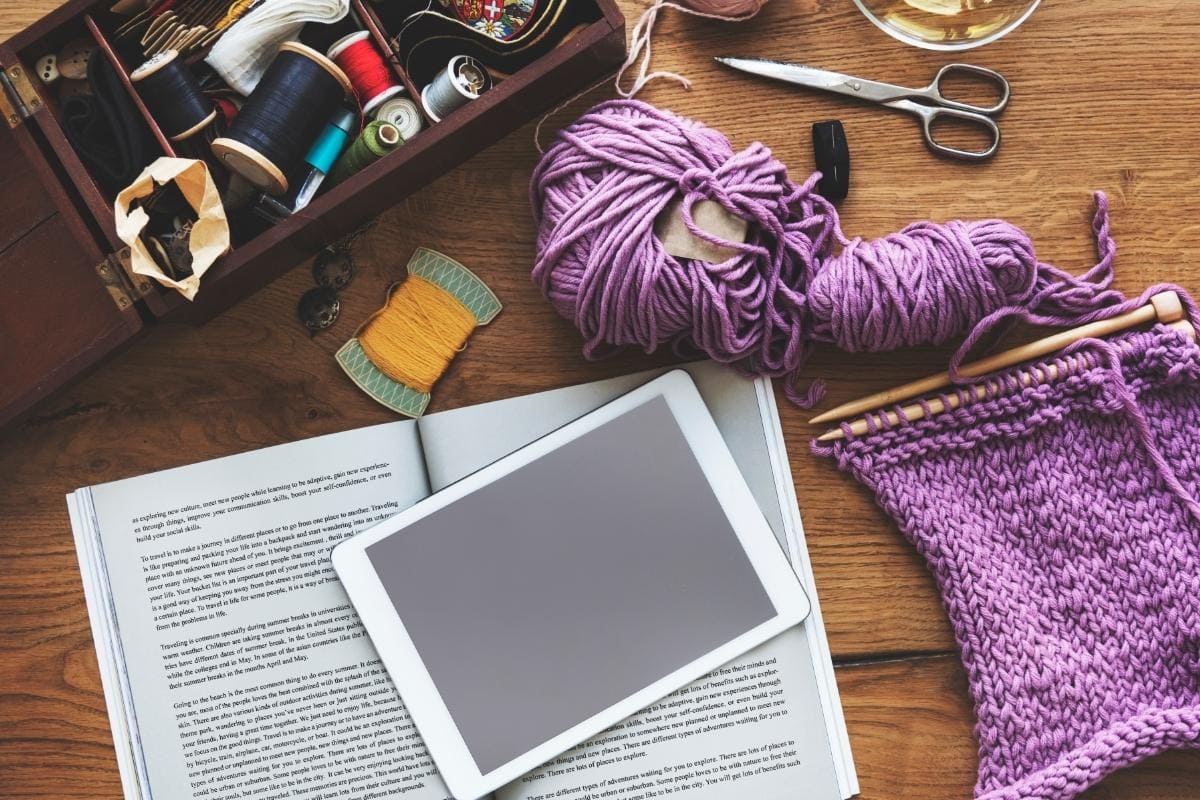
You’ll find that you accumulate quite a collection of books and snippets from crafting magazines as you get more and more into your new hobby. Build a reference library to keep everything tidy and within reach so that next time you want some guidance, you’ll have it at your fingertips.
Invest In Quality Tools
No matter what textile craft you take up, you’ll need a set of quality tools. Don’t skimp on quality! No one can produce good work with blunt scissors, needles that are impossible to thread, or a sewing machine that keeps jamming, so be prepared to spend a bit more and buy the best tools you can afford.
Learn From Mistakes
Don’t get discouraged if you do something wrong or if one of your projects is a disaster! The best way to learn is from your mistakes and those of your fellow crafters.
If you get something wrong, you instantly remember not to make that mistake twice; that’s just part of the learning process.
Share Your Work
As you become more proficient and the quality of your finished pieces improves, you can begin sharing your work with friends, family, and your fellow crafters. You might want to set up a Facebook page or a website where you can record your crafting journey in pictures and share your work with others.
Stay Inspired
Keep inspired, especially when things don’t go according to plan and you get discouraged, by keeping up to speed with new developments in your textile craft and attending exhibitions, workshops, and demonstrations by experts.
Be Patient!
Learning any new skill takes time and effort; unfortunately, you can’t expect to become an expert overnight. Be patient, keep practicing, learn from others, and stay inspired!
Explore Advanced Techniques
A good way of maintaining your interest in your new hobby is by taking on more challenging projects. So, once you have the basics mastered, you should explore advanced techniques and try to become proficient in those, too.
Successfully completing a difficult project and producing an impressive piece of work is a surefire way of boosting your confidence and inspiring you to keep working on your crafting specialty. Who knows, if your work is good enough, you might even be able to generate an additional income by selling your projects to friends, family, online, or at local craft fairs.
What Are Some Examples Of Textile Craft Products?
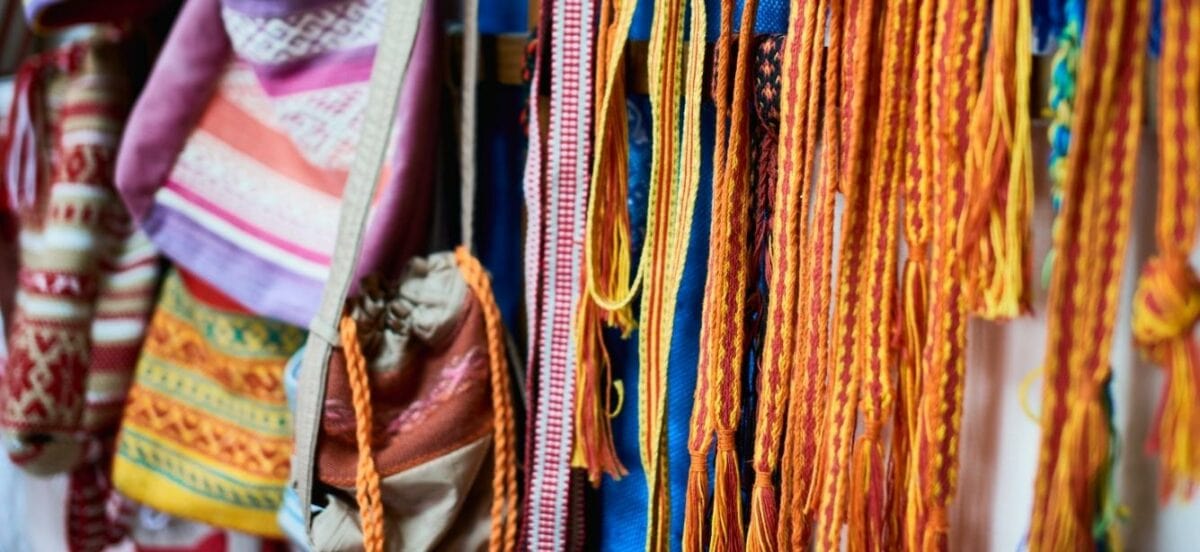
Examples of textile crafts include large, ambitious pieces like quilts, tapestries, and rugs. On a smaller scale, you can make decorative wall hangings and embellish or upcycle items of clothing.
To inspire and encourage you to get started, here are just a few of the things you could make from textile crafting.
Quilts
One of the most popular textile crafting projects is quilting. If you have lots of scraps of material lying around your workshop, you could create a beautiful quilt that could even become a family heirloom.
Clothing
If you want to save some money or you love to stand out from the crowd, you might want to make clothing for yourself and your family. When I was a child, my mom made a lot of my clothes, which saved a fortune, especially as I outgrew stuff pretty quickly!
Scarves
One of the simplest knitting projects to take on is making scarves. A scarf is a length of fabric, often wool, that can be made in any color or combination of colors and trimmed, adorned, or embellished to your taste.
Blankets
Blankets for use on your bed or as throws for your sofa can be made using woolen material in whatever colors and patterns suit your home decor scheme. You can also knit blankets but that’s a long project that will take you many hours to complete.
Wall Hangings
Textile wall hangings can be made using any fabric of your choice and decorated as you like. Rugs, tapestry, and embroidered samplers make popular decorative wall hangings.
Tote Bags
Tote bags are quick and easy to create, and making them is a popular crafting project that’s suitable for older kids.
Table Linens
If you take up stitching as a textile craft, you could make table linens like napkins and tablecloths to match your room decor, for seasonal events, such as Christmas and Halloween, or for birthdays and wedding celebrations.
Pillows
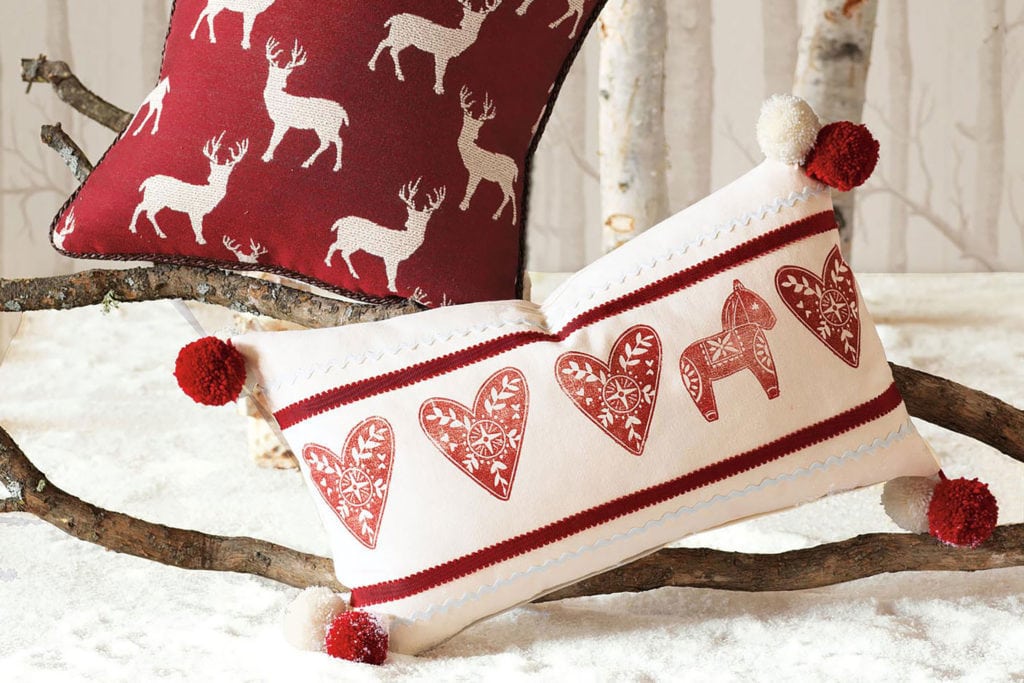
Pillows for your bed or for use on your sofa are easy and quick to make if you’re handy with a sewing machine. You can use any fabric you like and decorate the pillows with embellishments of your choice, such as ribbons and buttons. Pillow innards of different sizes and shapes can be bought from good haberdashery and fabric stores.
Doilies
If you take up lacemaking, you can make pretty doilies for use as coasters to protect wooden furniture from water damage or to put plant pots and ornaments on.
Rugs
As explained earlier in our guide, you can make rugs using various techniques. Rugs make excellent floor coverings to protect wooden flooring, warm up tiles, or to protect carpets in front of an open fire.
Jewelry
You can make small items of jewelry like earrings, brooches, and pendants from lace and flower art.
Wall Art
Textile wall art can bring a homely feeling to any room, and embroidered samples are a good example of popular forms of this craft.
Potholders And Oven Mitts
Oven mitts and potholders make a practical project that’s functional as well as decorative. You wear oven mitts to remove hot pots from your oven, protecting your hands from getting burnt.
Handbags And Clutches
You can make handbags and clutches by stitching pieces of fabric together, from lace or crochet. I’ve even seen a beautiful knitted clutch bag made from metallic yarn.
Dolls And Soft Toys
Kids love dolls and soft toys, and there are plenty of patterns available for fabric, felt, and knitted projects that could be used to create wonderful, unique birthday and Christmas gifts.
Hats
Hats to suit all seasons can be made from felt and fabric, and they can be crocheted and knitted, too. You can also upcycle old hats from charity stores and give them a new lease of life by adding decorations of your choice.
Aprons
Aprons are simple to make and are a great project for a beginner. Although using a sewing machine to stitch pieces of fabric together is quicker, you can hand-stitch if you prefer and add whatever embellishments you want.
Baby Items
You can make lots of different baby items, from bootees and bibs to hats to gorgeous christening gowns, depending on what textile crafts you’re into.
Upholstery
I have a friend who refurbishes old pieces of furniture by making fabric upholstery. For example, she recovers the body of an old wingback armchair and then makes cushions and bolsters to finish off her project.
Tea Towels
Making tea towels is extremely easy to do and doesn’t cost a fortune, so this is an excellent beginner project for novices in the stitching craft.
FAQs
In this part of our guide, we answer some of the most commonly asked questions about textile crafts.
What Are Some Beginner-Friendly Textile Craft Projects?
A few easy, beginner-friendly textile craft projects include:
- Drawstring bag
- Kitchen apron
- Reusable sandwich and snack bags
- Simple envelope pillow
- Fabric bunting garland
- Tea towels
All these projects need minimal sewing skills and are a great place to start your textile crafting journey.
What Safety Precautions Should I Take When Working With Textiles?
Most of the safety precautions you should take when working with textiles are pretty much common sense. Here’s a list of what to be aware of before you begin textile crafting:
- Use high-quality tools that won’t break easily and potentially cause injury.
- Adopt the correct posture when sitting at a table to work to avoid back strain.
- Use ergonomic tools to prevent wrist injuries and RSI.
- Use sharp scissors, needles, and pins.
- Keep your fingers clear of your sewing machine needle.
- Don’t hold pins in your mouth – you might accidentally swallow one.
- Don’t stitch over pins – sharp fragments can fly up and cause nasty eye injuries.
- Switch your sewing machine off before you change the needle.
- Don’t allow electrical cables to trail across the floor, presenting a tripping hazard.
- Don’t plug too many power cables into one wall socket in case you overload it.
- Dispose of broken needles and pins carefully and correctly.
Finally, working when you’re tired or inebriated is a recipe for disaster!
Are There Any Online Communities For Textile Craft Enthusiasts?
Yes, there are lots of online communities for textile craft enthusiasts, and it’s a great idea to join one!
Here are a few of the best ones on the net, but a quick Google search will bring up plenty more to check out.
What Are Some Popular Textile Craft Trends?
Some of the most popular textile craft trends include tatting, rug-making, flower crafts, and stitching. That said, there are plenty of textile crafts you can try your hand at until you find something that fits your skill set and ambitions.
Can Textile Craft Be A Profitable Hobby Or Business?
Yes, it is possible to make textile craft a profitable hobby or even turn it into a full-time business.
Of course, you’ll need to have some talent and be able to produce good-quality items that people want to buy, which could take some time if you’re a beginner. However, once you’re proficient at your chosen craft, you could sell your work to friends and family, set up a website with an online store, and sell your wares at local markets and craft fairs.
What Are The Essential Skills Every Textile Crafter Should Master?
You won’t establish very much unless you understand the tools and materials you’re going to work with, so take time to research them.
Many textile crafts involve reading a pattern, so you must understand how to interpret one. You must know how to mark and cut out your fabric and how to operate a sewing machine if you’re using one. Understanding how to sew a seam, hem a piece of fabric, and add buttons and other closures are also essential skills a textile crafter should master.
Of course, every textile craft demands a set of specific skills, so do your research before you dive in!
How Can I Preserve And Store My Textile Craft Projects?
It’s pretty unusual to complete any textile craft project in one sitting, especially something large like a quilt. So, you’ll need to have suitable storage options for projects in progress and for materials and tools.
If you have enough space in your home, it’s ideal to set aside a room for your crafting so that you don’t have to put everything away once you’ve started working. Of course, you might find your supplies migrating to your garage once your hobby gets going and you run out of space!
Old file cabinets, small tabletop draw units, and large plastic containers with lids are ideal for storing fabric, and old boxes can be used for buttons and beads. You’ll also need plenty of water-resistant plastic ziplock bags in different sizes in which to store your completed work and spare pieces of fabric.
Conclusion
Textile crafts are a versatile, varied hobby that can be undertaken on a small or grand scale, depending on what craft you decide to specialize in. Some textile crafts can be combined with others, giving you plenty of scope to work with.
Start by researching textile crafting and decide which one floats your boat before gathering the tools and materials you’ll need to get started. We recommend signing up for a few online courses and reading plenty of articles and books on your chosen craft. Also, it’s a good idea to join a community of crafters where you can learn the basics, hone your skills, and make new friends.
Once you’ve mastered the basics, you can learn more challenging techniques so that your work is good enough to share with others, give as gifts, or even sell to generate an extra income.

